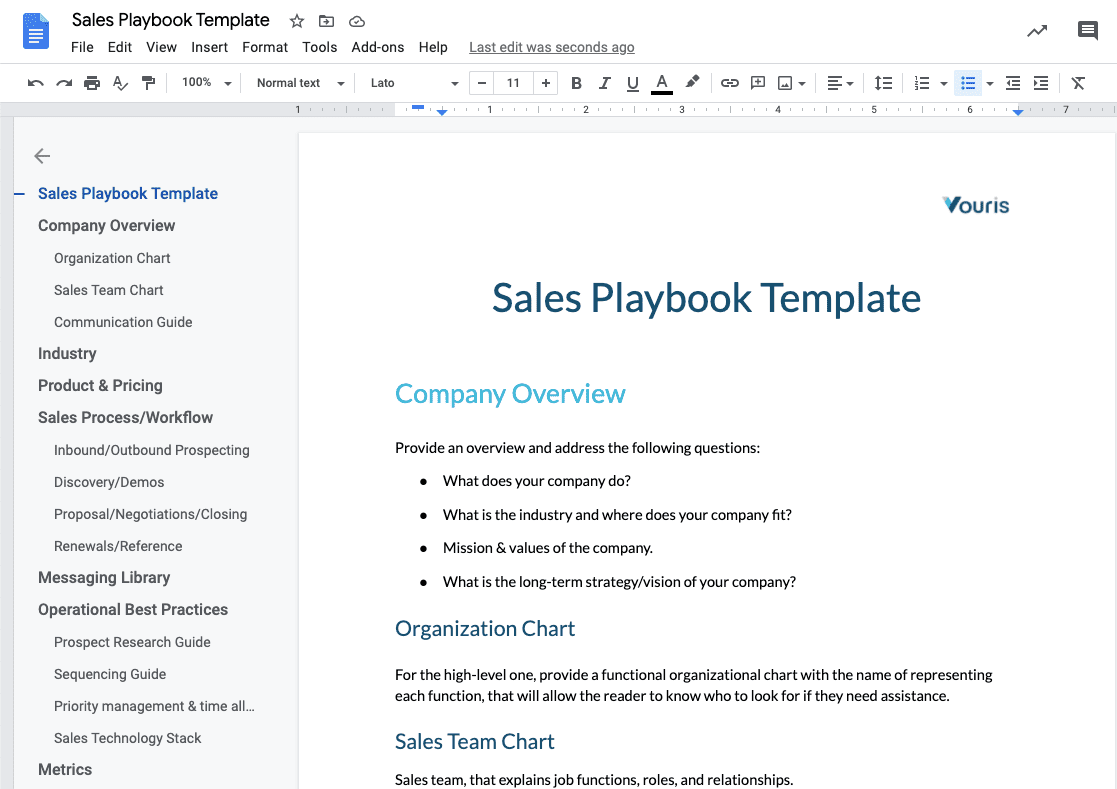Sales leaders are constantly pressured to meet ambitious targets, align teams, and handle complex buyer journeys. Without a structured approach, reps risk going off track, leading to lost deals, delays, and inconsistencies. That’s why having a sales playbook makes all the difference. It provides a structured, repeatable framework that helps sales teams stay focused and consistent, no matter how fast things move.
Here’s the catch: while companies with a playbook are 33% more likely to be high performers, 40% of sales teams still operate without one. This gap leaves revenue on the table and creates inefficiencies, making it harder for teams to reach their goals.
A well-built sales playbook doesn’t just lay out the steps to close a deal—it aligns your team, shortens onboarding and sales training time for new reps, and gives sales leaders the clarity they need to forecast accurately. Whether your goal is to streamline your sales process or improve team performance, adopting a sales playbook is the key to sustainable success.
In this article, we’ll walk through everything you need to know about creating a high-impact sales playbook—from the essential components to best practices and common pitfalls to avoid.
What Is A Sales Playbook?
A sales playbook is a guide that outlines the processes, best practices, and resources that sales teams need to engage prospects, close deals, and consistently hit targets. This process documentation outlines everything from ideal customer profiles and messaging frameworks to objection-handling tactics and key performance metrics.
Why Sales Playbooks Are Critical for Sales Success
Sales teams face unique challenges today, from managing complex buyer journeys to maintaining a consistent approach across various channels. Without a clear strategy, it’s easy for reps to feel overwhelmed or out of sync, which can lead to missed opportunities. That’s why a well-crafted sales playbook serves as an accessible standard operating procedure (SOP) for sales reps.
Having a sales playbook keeps everyone on the same page and impacts how the team operates. Some key benefits include:
- Keep messaging consistent at scale: When everyone follows the same processes and messaging, customers get a cohesive experience, which builds trust and boosts conversion rates.
- Accelerate sales onboarding with practical tools: New hires can dive into structured resources and practical examples, allowing them to ramp up quickly and gain confidence in their roles.
- Gain control over your sales pipeline: A sales playbook standardizes lead tracking and measurement, giving sales leaders the insights they need to make informed decisions and adjust strategies on the fly.
A solid sales playbook is more than just a document; it’s a crucial tool that helps teams navigate the complexities of sales, making success a shared journey for everyone involved.
Key Components of a Sales Playbook
Creating effective sales documentation involves several essential components that serve as the foundation for your sales strategy. Each element is critical in ensuring your team operates efficiently and consistently.
Here are the core components to include in your sales playbook:
- Ideal customer profile (ICP): Understanding your target market helps define who your ideal customers are, including their demographics, behaviors, and preferences.
- Sales process overview: A clear, step-by-step guide from prospecting to closing deals that outlines each phase of the sales cycle.
- Sales messaging framework: Consistent messaging, including scripts for outreach methods and pre-defined responses for common objections.
- Performance metrics and KPIs: To monitor team performance continuously, essential metrics like win rates, conversion rates, and sales velocity.
- Product and service overview: A comprehensive overview highlighting your offerings’ key features, benefits, and differentiators.
- Tools and resources: An overview of essential sales tools that support your team, like CRM systems.
- Sales enablement resources: Templates for proposals, case studies, and brochures to help communicate your value proposition effectively.
- Competitive analysis: Information on key competitors, their strengths and weaknesses, and strategies for overcoming objections.
- Sales training and onboarding: Guidelines for onboarding new team members, including training schedules, resources, and mentorship programs.
- Objection handling techniques: Specific strategies for addressing common objections to help reps respond confidently.
- Customer success stories: Real-world examples of how your products or services have solved customer problems.
- Sales roles and responsibilities: Clearly defining team members’ roles to enhance collaboration and accountability.
- Sales goals and objectives: Specific sales targets and objectives to align your team’s efforts with broader business goals.
How to Create a High-Impact Sales Playbook
Building a high-impact sales playbook requires a thoughtful approach that brings together insights from various teams and prioritizes usability. Here’s how you can create a playbook that truly empowers your sales force:
Step 1: Define the objectives and scope of the playbook
Start by clarifying what you want the playbook to achieve and who it will serve. Identify specific goals, such as improving onboarding speed, boosting win rates, or creating consistency across sales processes. You also need to decide whether the playbook will cover all aspects of the sales process or focus on a particular stage (like prospecting or closing).
Consider whether separate versions are needed—for example, tailored playbooks for different sales roles (account executives, BDRs) or enterprise vs. SMB sales. Setting clear goals and defining the scope ensures that the playbook remains focused and actionable.
Step 2: Gather input from key stakeholders
Collect insights from sales reps, managers, marketing, product, and customer success teams. Each stakeholder brings essential knowledge to the table:
- Sales reps provide practical insights into what works in the field
- Marketing ensures messaging is aligned with brand voice and target personas
- Product teams offer detailed product knowledge that enhances sales discussions
- Customer success teams share feedback on common customer pain points and success stories
Conduct interviews, workshops, or surveys to capture this information. The goal is to ensure the playbook reflects real-world scenarios and is relevant to the team.
Step 3: Map out the sales process
Lay out your entire sales process step-by-step. Identify every stage, from lead generation and qualification to closing the deal and post-sale activities. Break down each stage into tasks, timelines, and required actions.
For example:
- Prospecting: List outreach strategies, tools, and sample email templates.
- Discovery calls: Outline key questions to uncover customer needs.
- Negotiation and closing: Provide pricing guidelines, objection-handling techniques, and contract templates.
Business process mapping helps structure the sales playbook logically, ensuring it flows in a way that mirrors real-world sales interactions.
Step 4: Develop a content structure and outline
Now that you’ve mapped the sales process, organize your playbook into sections. Create a clear content structure that makes it easy to navigate. Use text, templates, and visuals to make the content user-friendly. Add checklists at the end of each section for quick reference.
Step 5: Create or gather supporting assets
Once the structure is in place, develop templates, guides, and other materials to support your sales team. Some examples include:
- Email templates for follow-ups and outreach
- Sales call scripts and objection-handling frameworks
- Product one-pagers, brochures, and case studies
- Competitor comparison sheets
Step 6: Collaborate on drafting and reviewing content
Drafting the playbook is a collaborative process. Assign writers from the relevant teams to develop content for their sections. Set submission deadlines and create a review process that involves team leads and stakeholders from all departments.
Encourage feedback and ensure each section aligns with the overall objectives. Make adjustments where necessary to keep the content actionable and relevant. A review board or editor can ensure consistency in tone and language.
Step 7: Build the playbook in a user-friendly format
Choose a format that’s easy to access and navigate. Whether your playbook is a PDF, an online wiki, or embedded within your CRM, make sure it’s intuitive and well-organized.
If the playbook is digital, Whatfix’s in-app guidance can transform it into an interactive experience. Instead of static documents, reps can access relevant sections or best practices directly within the tools they use through on-screen navigation menus, pop-ups, and tooltips. With on-demand walkthroughs and self-help widgets, Whatfix ensures reps can quickly find the information they need, making the playbook more actionable and usable in real time.
Step 8: Pilot the playbook with a small team
Before rolling out the playbook company-wide, test it with a small group of reps. This pilot phase helps identify any missing information or gaps. Collect feedback on how easy the playbook is to use and whether it adds value during their workflow.
With Whatfix analytics, you can track how sales reps interact with your sales playbook during the pilot phase, measuring usage patterns, feature adoption, and time spent on specific sections. This data-driven insight highlights which areas resonate with reps and where they struggle, allowing you to refine content and improve usability.
Whatfix in-app surveys can also collect real-time feedback from your pilot group, helping you uncover pain points and make targeted adjustments before launching the playbook to the entire team.
Step 9: Launch and train the sales team
Introduce the playbook to the entire sales team through training sessions, workshops, or webinars. Walk them through each section, focusing on how it will make their day-to-day processes more efficient.
Whatfix’s in-app training modules deliver step-by-step guidance directly within your CRM, ensuring that reps can practice the playbook’s processes in the exact environment where they’ll use them. This eliminates the need to switch between multiple platforms or documents.
With contextual learning delivered at the point of need, sales reps can receive reminders or instructions as they complete sales tasks, reinforcing key concepts on the job. This seamless integration improves adoption, making it easy for the playbook to become part of their daily routines from day one.
Step 10: Monitor usage and continuously improve the playbook
Once the playbook is live, track how your team interacts with it. Use feedback loops, performance metrics, and CRM data to identify areas for improvement. Monitor how frequently the playbook is accessed, which sections are most useful, and where reps still face challenges. Schedule periodic reviews (quarterly or biannually) to refresh content based on market changes or strategy shifts.
Related Resources
Common Pitfalls to Avoid When Developing a Sales Playbook
Creating a sales playbook is a valuable endeavor, but it’s essential to be aware of common pitfalls that can undermine its effectiveness.
Here are three critical mistakes to avoid:
1. Overloading your sales playbook with too much information
One of the biggest mistakes you can make is cramming your playbook with excessive details. While it’s important to provide thorough guidance, overwhelming your team with information can lead to confusion and frustration.
Instead, focus on clarity and conciseness. Highlight the most crucial processes and key takeaways to ensure your sales reps can quickly find the information they need without sifting through pages of content.
2. Failing to update the playbook regularly
A static playbook can quickly become outdated and irrelevant. The sales landscape changes at the drop of a hat, with new trends, tools, and strategies emerging all the time. If your playbook isn’t updated regularly, your team might miss out on essential information that could enhance their performance.
Schedule regular reviews to incorporate feedback and refresh content, ensuring that your playbook remains a valuable resource for your sales team.
3. Lack of alignment between sales and marketing
For a sales playbook to be truly effective, sales and marketing teams should be on the same page. A disconnect between these teams can lead to inconsistencies in messaging and missed opportunities.
Foster collaboration between sales and marketing during the development process to ensure that both perspectives are reflected in the playbook. This alignment helps create a unified approach that resonates with prospects and customers alike.
Best Practices for Implementing a Sales Playbook
Implementing a sales playbook is just as crucial as creating one. To ensure your playbook delivers the intended results, consider these best practices:
1. Train your team effectively
Proper training is essential for maximizing the impact of your sales playbook. Use role-playing exercises and real-life scenarios that mimic actual sales situations to engage your team. This makes the learning experience interactive and helps sales reps internalize processes and develop their skills in a safe environment. When team members actively participate in training, they’re more likely to remember the techniques and strategies outlined in the playbook.
Whatfix can support this training by providing in-app guidance that delivers contextual information at the moment of need. As reps navigate their CRM or other sales tools, they can access playbook insights and best practices without needing to refer back to a separate document. This seamless integration into their daily workflows makes the training process more intuitive and effective.
2. Align playbook adoption with your CRM for seamless access
Integrating your sales playbook within your CRM ensures that sales reps have instant access to guidance while they work. This approach transforms the playbook from a static reference document into a dynamic tool that supports reps in real time.
Embedding in-app instructions using a tool like Whatfix provides real-time support, guiding reps through key processes as they navigate the CRM. This integration enhances the user experience and promotes quicker adoption of the playbook. When sales reps see the value of having contextual information at their fingertips, they’re more likely to engage with the playbook and apply its teachings.
Whatfix enhances this process by allowing you to track how often reps use specific playbook features within their CRM. By analyzing usage data, you can identify which sections are most helpful and which may need further clarification or enhancement. This data-driven approach enables you to refine the playbook based on actual user behavior, driving better results over time.
3. Reinforce playbook adoption through gamification
Introduce gamification elements, such as leaderboards, badges, or challenges, to motivate your sales team to engage with your sales playbook. Recognizing and rewarding sales reps who effectively utilize the playbook and achieve key milestones creates a sense of competition and camaraderie within the team. Gamification can enhance morale and engagement, making the learning process enjoyable and motivating.
When sales reps see tangible rewards for their efforts, they’re much more likely to engage with the playbook and internalize its teachings. This strategy drives adoption and fosters a culture of achievement and collaboration among team members.
Tools to Build and Manage a Sales Playbook
Creating and managing an effective sales playbook requires the right tools to support your team’s efforts. Here are three categories of tools that can help streamline the process:
1. Knowledge management tools to centralize and organize playbook content
A knowledge base provides a single source of truth for your sales playbook, ensuring information is well-organized, easy to access, and always up-to-date. These platforms go beyond static documents, offering searchable and interactive formats that empower sales teams to quickly find the guidance they need, whether it’s a product pitch, objection-handling script, or sales process step.
Knowledge sharing platforms like Notion or Confluence help teams collaborate, edit, and refine content over time while keeping everything easily accessible across devices.
Key features:
- Quickly update sections when strategies shift or new product features launch without issuing a new version of the entire playbook.
- Reps can search for relevant information instantly, reducing time spent digging through documents.
- Use built-in templates to ensure playbook sections follow a standard format.
- Sales managers and reps can leave comments, suggest changes, or co-author sections directly within the platform.
- Ensure the right people see the right information by segmenting access by role or team.
2. Performance management platforms to track engagement and outcomes
Performance management tools ensure that the strategies outlined in the playbook are followed and measured effectively. These platforms integrate gamification and performance-tracking features to keep reps engaged with the content, ensuring continuous improvement. Managers gain insights into which parts of the playbook are being utilized and which need refinement based on rep performance data.
Tools like Ambition and Mindtickle offer features that align individual and team performance with playbook goals, promoting consistent execution and accountability.
Key features:
- Visualize which reps are meeting key metrics, such as quota attainment or win rates, tied directly to playbook strategies.
- Motivate reps with leaderboards, badges, and competitions based on their engagement with the playbook and KPIs.
- Identify how closely reps are following the outlined processes and where deviations occur.
- Provide personalized coaching to reps struggling with specific sections of the playbook.
- Create structured learning paths aligned with the playbook, rewarding reps as they demonstrate mastery.
3. Digital adoption platforms (DAP) to boost efficiency
Digital adoption platforms (DAP) like Whatfix are designed to simplify the onboarding and training process. These tools offer in-app guidance, making it easier for sales reps to navigate CRMs and other software while applying the principles from the playbook.
With step-by-step walkthroughs and contextual tips, Whatfix helps reduce the time it takes for your team to become proficient in using technology. This support can significantly boost adoption rates and ensure your playbook is utilized to its fullest potential.
Key features:
- Contextual in-app guidance to provide support during real-time tasks
- Interactive walkthroughs that guide users through complex processes
- Customizable tooltips and messages tailored to specific workflows
- Analytics to track user engagement with playbook content
- Ability to update guidance instantly, ensuring that the playbook remains relevant without disrupting user experience
3 Sales Playbook Template Examples
If you’re new to the sales playbook game, it might be difficult to know where to begin when creating your own guide.
To help you get started, we’ve compiled three excellent sales playbook template examples:
1. Hubspot
In Hubspot’s free template, you can work through your sales plan and playbook simultaneously to ensure they’re consistent and harmonious. Compile your company’s sales strategy and processes in one simple template and align your teams on your goals, messaging, and best practices.
2. Revenue
Outlining the onboarding process is essential for ramping up new hires as quickly and efficiently as possible. Revenue offers a new-hire ramping playbook that includes 3 types of onboarding material, a day-by-day guide to ramping new hires in 6 weeks, and more.
3. Vouris
Vouris generously provides a free Google Doc version of a sales playbook template, making it easily accessible and customizable. The template includes sections on your company overview, product, messaging, and best practices – all elements of a winning playbook. Simply download or make a copy of the doc template and start customizing.
Sales Playbooks Click Better With Whatfix
A well-crafted sales playbook is a powerful tool—but it’s only as effective as the team’s ability to adopt it.
With Whatfix, sales leaders can ensure their teams access the playbook and actively engage with it through seamless, in-the-moment guidance and support.
Here’s how Whatfix enhances your sales playbook:
- In-app walkthroughs for CRMs: Guide sales reps step-by-step within platforms like Salesforce, HubSpot, or any CRM you use. This ensures they follow the processes outlined in the playbook without disruption.
- On-demand learning embedded into workflows: Whatfix offers contextual, bite-sized learning resources that reinforce key playbook concepts, helping reps apply them right when they need them.
- Automated onboarding for new reps: Accelerate the onboarding process with personalized learning paths, equipping new team members to hit the ground running faster.
- Real-time updates and alerts: Keep your playbook dynamic by delivering instant updates directly within your team’s tools, ensuring everyone stays aligned with new strategies and messaging.
- Performance analytics for continuous improvement: Track how your team interacts with the playbook and identify areas for refinement through Whatfix’s analytics, ensuring your playbook evolves as your business grows.
With Whatfix, your sales playbook becomes more than a static document—it transforms into an interactive, living resource that aligns perfectly with your sales team’s daily workflows. By making it easier for your reps to learn, adopt, and execute, Whatfix helps drive consistency, improve performance, and unlock the full potential of your sales team.
Empower your sales team with Whatfix and transform your sales playbook into a dynamic resource.
Sales Playbook + FAQs
What’s the difference between a sales playbook and a sales strategy?
A sales playbook is a document that outlines specific processes, tools, and best practices for sales representatives. A sales strategy is a broader plan that defines overall goals, target markets, competitive positioning, and key performance indicators. Essentially, the playbook supports the execution of the larger sales strategy.
How often should a sales playbook be updated?
To keep your sales playbook fresh and relevant, aim to update it every few months—quarterly or biannually is a good rhythm. Regular reviews help you adapt to market shifts or changing customer needs. Plus, gathering input from your sales team can uncover valuable insights that ensure the playbook continues to meet their needs and reflects the latest strategies.
Can small businesses benefit from sales playbooks?
Yes, small businesses can benefit from sales playbooks. They offer a structured way to approach sales, which helps ensure everyone’s on the same page and working efficiently. A solid playbook makes it easier to onboard new team members and streamlines sales efforts overall. This clarity can lead to better performance and give small businesses the boost they need to grow.
How can a digital adoption platform (DAP) enhance playbook effectiveness?
A DAP enhances sales playbooks by providing in-the-moment guidance and support for sales reps. This means they can access insights and best practices right when needed, without having to sift through a separate document or training material. By encouraging learning on the job, a DAP builds confidence and makes it easier for reps to adopt the playbook.









